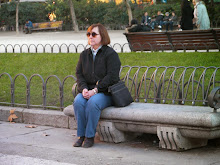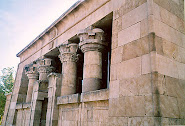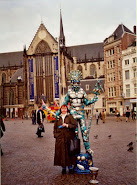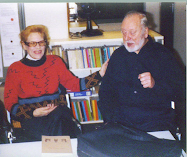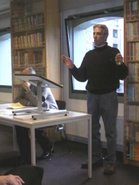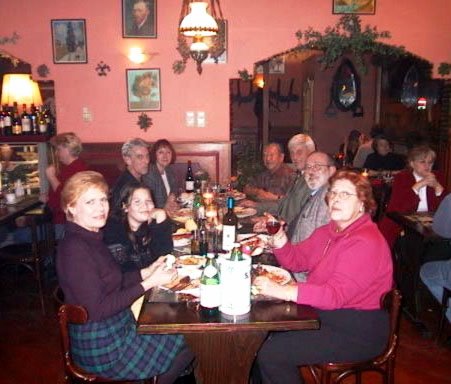Saturday, June 27, 2009
A Tale of the Goddess Durga
The Earliest Wheeled Vehicles
 Men and their toys! When I was in high school the guys who attracted the girls had muscle cars, 450 hp eight (or more) cylinder Roadrunners, etc., with jazzy racing stripes :)
Those days are long gone, but men have always liked their wheeled toys. Here, for instance, is a specimen (in miniature) from the 2nd half of the 3rd millenium BCE; if I'm doing my math right, that is about 2500-2000 BCE. If that is a "nostril" I'm seeing, than this is probably a camel - otherwise, my first impression was "possibly a horse." My question is - why isn't it out in front of the cart instead of looking like a "camel figurehead" (like on a ship) built into the cart? It was obviously not meant to be a real-life representation of a camel-pulled cart. The camel has no legs, for one thing, and there are no reins showing. It seems it was not meant to represent reality.
On the other hand, I could easily imagine this model as a very early rook (the old war chariot chess piece used by the Persians). (Image: Lyubov Kircho, Early Wheels: This model dates to near the second part of the 3rd millennium B.C. and shows one of the first known carts. The model is now in St. Petersburg's State Hermitage museum.)
The title of the article below is a bit misleading, because nowhere in the body of the article does it mention when this particular model was discovered and excavated; instead, it mentions "a new analysis." That seems to be a tip-off that this particular artifact (and others) have been known for some time.
Models of Earliest (Camel-Pulled) Vehicles Found
Jennifer Viegas, Discovery News
June 26, 2009 -- Some of the world's first farmers may have sped around in two-wheeled carts pulled by camels and bulls, suggests a new analysis on tiny models of these carts that date to 6,000-5,000 years ago.
The cart models, which may have been ritual objects or children's toys, were found at Altyndepe, a Chalcolithic and Bronze Age settlement in Western Central Asia near Ashgabat, Turkmenistan. Together with other finds, the cart models provide a history of how wheeled transportation first emerged in the area and later developed.
"Horsepower" is a common term today, but the ancients had bull-power, followed by camel-power, researcher Lyubov Kircho explained to Discovery News.
"I think that the carts pulled by bulls were mostly used in agriculture in the 4th millennium, when the climate was more humid," said Kircho, who is at the Institute for the History of Material Culture at the Russian Academy of Sciences.
His study, published in Russian, appears in the journal Archaeology, Ethnology and Anthropology of Eurasia. An English version has been accepted for publication in the Proceedings of the 19th International Conference of the European Association of South Asian Archaeologists.
Men and their toys! When I was in high school the guys who attracted the girls had muscle cars, 450 hp eight (or more) cylinder Roadrunners, etc., with jazzy racing stripes :)
Those days are long gone, but men have always liked their wheeled toys. Here, for instance, is a specimen (in miniature) from the 2nd half of the 3rd millenium BCE; if I'm doing my math right, that is about 2500-2000 BCE. If that is a "nostril" I'm seeing, than this is probably a camel - otherwise, my first impression was "possibly a horse." My question is - why isn't it out in front of the cart instead of looking like a "camel figurehead" (like on a ship) built into the cart? It was obviously not meant to be a real-life representation of a camel-pulled cart. The camel has no legs, for one thing, and there are no reins showing. It seems it was not meant to represent reality.
On the other hand, I could easily imagine this model as a very early rook (the old war chariot chess piece used by the Persians). (Image: Lyubov Kircho, Early Wheels: This model dates to near the second part of the 3rd millennium B.C. and shows one of the first known carts. The model is now in St. Petersburg's State Hermitage museum.)
The title of the article below is a bit misleading, because nowhere in the body of the article does it mention when this particular model was discovered and excavated; instead, it mentions "a new analysis." That seems to be a tip-off that this particular artifact (and others) have been known for some time.
Models of Earliest (Camel-Pulled) Vehicles Found
Jennifer Viegas, Discovery News
June 26, 2009 -- Some of the world's first farmers may have sped around in two-wheeled carts pulled by camels and bulls, suggests a new analysis on tiny models of these carts that date to 6,000-5,000 years ago.
The cart models, which may have been ritual objects or children's toys, were found at Altyndepe, a Chalcolithic and Bronze Age settlement in Western Central Asia near Ashgabat, Turkmenistan. Together with other finds, the cart models provide a history of how wheeled transportation first emerged in the area and later developed.
"Horsepower" is a common term today, but the ancients had bull-power, followed by camel-power, researcher Lyubov Kircho explained to Discovery News.
"I think that the carts pulled by bulls were mostly used in agriculture in the 4th millennium, when the climate was more humid," said Kircho, who is at the Institute for the History of Material Culture at the Russian Academy of Sciences.
His study, published in Russian, appears in the journal Archaeology, Ethnology and Anthropology of Eurasia. An English version has been accepted for publication in the Proceedings of the 19th International Conference of the European Association of South Asian Archaeologists.
Friday, June 26, 2009
Friday Night Miscellany
 Tonight has a theme: Horrors of Mother Nature EEK EEK EEK!
Tonight has a theme: Horrors of Mother Nature EEK EEK EEK!
- I'm starting out this Friday night's edition of the Miscellany with an incredible paranoid fantasy. I laughed so hard while reading it I nearly peed my pants! Well, okay, I did - but just a little bit...
- This is from http://www.infowars.com/. I haven't seen this site before (paranoid fantasies are not my thing) but I'm sure there must be a kazillion of them out there right now, probably multiplying like rabbits since - GASP! - a Black African Radical Islamist Nazi who is not even a US citizen and was born to a Commie whore mother is now President of the US of A. GASP! And his wife is a Zombie. GASP! The dog, too. GASP GASP!! And the dog was a Voodoo Priest in a former life (everyone knows that, YAWN). I selected a few particularly juicy selections from the lengthy article for your reading enjoyment, darlings. Perhaps we should email Ms. Minton and ask her to show us past articles she has written about such monstrous conspiracies that have come true! GASP!
Journalist Files Charges against WHO and UN for Bioterrorism and Intent to Commit Mass Murder Barbara Minton Natural News June 25, 2009 Using the “swine flu” as a pretext, the defendants [President Obama, numerous appointees, bankers, two pharmaceutical companies, and a host of others] have preplanned the mass murder of the U.S. population by means of forced vaccination. They have installed an extensive network of FEMA concentration camps and identified mass grave sites, and they have been involved in devising and implementing a scheme to hand power over the U.S. to an international crime syndicate that uses the UN and WHO as a front for illegal racketeering influenced organized crime activities, in violation of the laws that govern treason. . . .pharmaceutical companies consisting of Baxter, Novartis and Sanofi Aventis are part of a foreign-based dual purpose bioweapons program, financed by this international criminal syndicate and designed to implement mass murder to reduce the world’s population by more than 5 billion people in the next ten years. Their plan is to spread terror to justify forcing people to give up their rights, and to force mass quarantine in FEMA camps. The houses, companies and farms and lands of those who are killed will be up for grabs by this syndicate. Okay - go ahead and wipe out 5 billion of us but please, start with the asshole Ayatollahs in Iran. Problem is, if the world's population is reduced to 1 billion from over 6 billion, none of that property, natural resources and land that this alleged international criminal syndicate is going to suck up at bargain prices (or for free) is going to be worth a flying fig for hundreds of years to come because there won't be any people around to CONSUME. Duh! No people to consume, no way to make wealth. Obviously none of these criminals who form this international syndicate have read "The Wealth of Nations." Geez, what is this world coming to when supposedly highly educated super-criminals intent on taking over the world haven't even read "The Wealth of Nations?" The other obvious "gotcha" is this - if one is going to play Almighty Goddess and destroy most of the population of the earth, one had better make sure that one has considered ALL contingencies before executing one's plan. The problem is that if humans are attempting to play Almighty Goddess, they do not have Almighty Goddess' powers to control everything and anything or, even with the aid of the most powerful computers, anticipate everything and plan accordingly. Unleashing a lethal virus among the population - ala "The Stand" (probably the best book Stephen King ever wrote) introduces the chance for random mutations to develop, and there will ALWAYS be some people who will NOT DIE LIKE THEY SHOULD. Uh oh. Mother Nature can be such an unruly bitch. There will also be some people who will not be vaccinated no matter what - like me. And just what does this international criminal syndicate expect people to do once they start dying because they've been vaccinated? People are not as stupid as governments (and international criminal syndicates) imagine. We are usually just busy doing other things - like, uh, living! Thing is, they cannot vaccinate the entire population of the USA in one day so that we all die at the same time. There are simply not enough people around to poke people with needles to insure this. Do you suppose the people who have not been vaccinated at that point won't be able to put 2 and 2 together and shoot to kill anyone who attempts to come near them with a needle as they see wave after wave of vaccinated people dying? Come on, dudes.
- Nope - you can never anticipate what Mother Nature may or may not do. Here's an interesting example of how She acts in strange and uncanny ways - in ways that cannot be anticipated or even understood; even with a great deal of study we do not entirely understand how interrelated and complex is the system under which our Earth works. Check this out: Ozone hole has unforeseen effect on ocean carbon sink 12:54 26 June 2009 by Kate Ravilious
Yet more about the incredible possibilities (and potential horrors) that are lurking under Mother Nature's Terra Incognito. Here's a great teaser quote:
Research over the past two decades has shown that the energy trapped in ice within the permafrost and under the sea rivals that in all oil, coal and conventional gas fields, and could power the world for centuries to come. Imagine putting a match to an ice cube, and the damn thing bursts into flame... Ice on Fire: The next fossil fuel 24 June 2009 by Fred Pearce
- And yet another good trick Mother Nature played on stupid Homo Sapiens Sapiens (we're supposed to be the Crowning Achievement of EVOLUTION? Geez!) when Hurricane Andrew blew through Florida and environs in 1992, shattering windows of pet shops that released Burmese pythons (and who knows what else?) into the local environment: "...counting pythons in the wild is a daunting task. Scientists don't have an accurate estimate of how many pythons are in Florida. "It's certainly in the thousands, or tens of thousands, if not hundreds of thousands," said Gibbons."
And now, they're coming to get us, us northerners, slithering their way north as sure as shooting... Burmese pythons slithering their way north? By ALYSIA PATTERSON – 2 days ago
RUN - RUN FOR THE HILLS! IT'S THE END OF THE WORLD AS WE KNOW IT, EEEEEEEEEEEEEEKKKKKKKKK!
Thursday, June 25, 2009
White Mares and Crop Circles
 Epona is a Celtic horse goddess - a White Mare. A nice play of words could be made on Night Mare, and probably was, hmmm...
Great Britain is known for the outlines of large white horses carved into underlying chalk deposits. Most of the horses aren't very old - at least, they cannot be classified as "ancient."
There is one "white horse" that has drawn more than the usual attention by way of strang crop circle formations (for years). It's located near the Village of Alton Barnes in Wiltshire, England, on Milk Hill. This chalk horse outline is not ancient. It seems it was first created around the year 1812.
Above is a photo of a current crop circle that appeared in a field lying below the Alton Barnes (or Milk Hill) white horse. The image is from Crop Circle Connector.com and was reported just a few days ago, on June 21, 2009. The first day of Summer. The photo was taken by Lucy Pringle.
Epona is a Celtic horse goddess - a White Mare. A nice play of words could be made on Night Mare, and probably was, hmmm...
Great Britain is known for the outlines of large white horses carved into underlying chalk deposits. Most of the horses aren't very old - at least, they cannot be classified as "ancient."
There is one "white horse" that has drawn more than the usual attention by way of strang crop circle formations (for years). It's located near the Village of Alton Barnes in Wiltshire, England, on Milk Hill. This chalk horse outline is not ancient. It seems it was first created around the year 1812.
Above is a photo of a current crop circle that appeared in a field lying below the Alton Barnes (or Milk Hill) white horse. The image is from Crop Circle Connector.com and was reported just a few days ago, on June 21, 2009. The first day of Summer. The photo was taken by Lucy Pringle.
 In this depiction, Epona reminds of an older goddess, The Mistress of Beasts, a/k/a Astarte a/k/a Artemis. In those older renditions of the Goddess, she is sometimes depicted as a tree (Tree of Life) flanked on either side by rampant deer-like creatures or other wild life, sometimes depicted as a Goddess or woman with a crown flanked by rampant wild beasts. This image of Epona is from Wikipedia and dates to the 4th century CE from Greek Macedonia, and depicts the Goddess Epona flanked by two pairs of horses. The four knights on the chessboard???
In this depiction, Epona reminds of an older goddess, The Mistress of Beasts, a/k/a Astarte a/k/a Artemis. In those older renditions of the Goddess, she is sometimes depicted as a tree (Tree of Life) flanked on either side by rampant deer-like creatures or other wild life, sometimes depicted as a Goddess or woman with a crown flanked by rampant wild beasts. This image of Epona is from Wikipedia and dates to the 4th century CE from Greek Macedonia, and depicts the Goddess Epona flanked by two pairs of horses. The four knights on the chessboard???
This Little Thing is Worth - Ohmygoddess!
 From the Mail Online
The beep that made me leap: Housewife discovers £250,000 gold treasure after seven years of hunting with a metal detector
By Dalya Alberge
Last updated at 11:18 PM on 24th June 2009
(Image: (c) David Crump. Tiny: The 2.8cm by 2.3cm treasure)
After seven years of combing fields and beaches with a metal detector, the only thing housewife Mary Hannaby had to show for her hobby was an old dental plate.
But all those efforts paid off when her first proper find turned out to be a 15th-century gold treasure valued at £250,000 or more.
The find is thought to be part of a high-quality reliquary or pendant, and depicts the Holy Trinity.
Mrs Hannaby, 57, from Hemel Hempstead, Hertfordshire, heard her metal detector's tell-tale beep while out on one of her regular six-hour Sunday detecting walks with her son, woodcarver Michael, 33.
For 500 years, the treasure had lain buried four inches below the ground, despite repeated ploughing.
The discovery is all the more astonishing as this was not the first time the Hannabys had scoured the arable field between Ashridge and Great Gaddesden.
'You get a buzz every time you get a signal, but chances are it won't be anything,' said Mrs Hannaby.
'This time, it popped up all of a sudden,' said her son. 'You can literally miss things by inches. We couldn't believe it. We always dreamed of finding treasure.'
And the pair struck gold again when the landowner refused Mrs Hannaby's offer to split the money equally and said he wanted only 30 per cent, saying he would never have known about the treasure if not for her.
Under the Treasure Act of 1996, finders must report potential treasure such as gold and silver objects more than 300 years old. Finders are offered the market value for their discoveries which museums have first option to buy.
At 2.8cm by 2.3cm, the treasure is barely larger than a postage stamp, but its importance is exciting experts. Roger Bland, head of treasure at the British Museum, describes it as an 'important find', and regrets that the museum does not currently have the funds to buy it.
Carolyn Miner, sculpture specialist at Sotheby's, was 'awestruck' when the Hannabys first showed the treasure to her and will auction it in London on July 9.
As one of only three of its kind to have survived, the find could be worth even more than £250,000, and its engraving is being compared to that of the Middleham Jewel, which sold at auction for £1.3 million in 1986 and was later resold to the Yorkshire Museum for £2.5 million.
Former pub kitchen worker Mrs Hannaby hopes the sale proceeds will pay off her mortgage.
From the Mail Online
The beep that made me leap: Housewife discovers £250,000 gold treasure after seven years of hunting with a metal detector
By Dalya Alberge
Last updated at 11:18 PM on 24th June 2009
(Image: (c) David Crump. Tiny: The 2.8cm by 2.3cm treasure)
After seven years of combing fields and beaches with a metal detector, the only thing housewife Mary Hannaby had to show for her hobby was an old dental plate.
But all those efforts paid off when her first proper find turned out to be a 15th-century gold treasure valued at £250,000 or more.
The find is thought to be part of a high-quality reliquary or pendant, and depicts the Holy Trinity.
Mrs Hannaby, 57, from Hemel Hempstead, Hertfordshire, heard her metal detector's tell-tale beep while out on one of her regular six-hour Sunday detecting walks with her son, woodcarver Michael, 33.
For 500 years, the treasure had lain buried four inches below the ground, despite repeated ploughing.
The discovery is all the more astonishing as this was not the first time the Hannabys had scoured the arable field between Ashridge and Great Gaddesden.
'You get a buzz every time you get a signal, but chances are it won't be anything,' said Mrs Hannaby.
'This time, it popped up all of a sudden,' said her son. 'You can literally miss things by inches. We couldn't believe it. We always dreamed of finding treasure.'
And the pair struck gold again when the landowner refused Mrs Hannaby's offer to split the money equally and said he wanted only 30 per cent, saying he would never have known about the treasure if not for her.
Under the Treasure Act of 1996, finders must report potential treasure such as gold and silver objects more than 300 years old. Finders are offered the market value for their discoveries which museums have first option to buy.
At 2.8cm by 2.3cm, the treasure is barely larger than a postage stamp, but its importance is exciting experts. Roger Bland, head of treasure at the British Museum, describes it as an 'important find', and regrets that the museum does not currently have the funds to buy it.
Carolyn Miner, sculpture specialist at Sotheby's, was 'awestruck' when the Hannabys first showed the treasure to her and will auction it in London on July 9.
As one of only three of its kind to have survived, the find could be worth even more than £250,000, and its engraving is being compared to that of the Middleham Jewel, which sold at auction for £1.3 million in 1986 and was later resold to the Yorkshire Museum for £2.5 million.
Former pub kitchen worker Mrs Hannaby hopes the sale proceeds will pay off her mortgage.
Farrah Fawcett's Best Performance
 Farrah Fawcett died today.
I will always remember Farrah's performance in a made-for-tv movie I saw years ago.
I couldn't remember the name of the movie or what year it was, but I found it at Amazon.com: "The Substitute Wife." She played a worn-out prostitute who was recruited by a farmer in the 1880's or thereabouts, whose wife was dying. The wife had sent him out to find a replacement woman who would take over as his wife and mother to their several children once she had died.
I thought it was the best thing Ms. Fawcett ever did. Nuanced, hard and vunerable at the same time, proud and humble, weary-wise and yearning for love, that finally came, when all thought and hope had long since vanished from her life.
Two VHS videos of this movie are going for $146.99 while I'm writing this. I suppose more may come on the market now, and the price will go even higher.
Like lots of other people back then, I watched "Charlie's Angels." I wasn't particularly a Farrah fan (no sex appeal for me!), but I liked Kate Jackson and I thought the most beautiful of the three original Angels is Jaclyn Smith. The three of them together were (to steal a phrase) DY-NO-MITE!
Farrah Fawcett died today.
I will always remember Farrah's performance in a made-for-tv movie I saw years ago.
I couldn't remember the name of the movie or what year it was, but I found it at Amazon.com: "The Substitute Wife." She played a worn-out prostitute who was recruited by a farmer in the 1880's or thereabouts, whose wife was dying. The wife had sent him out to find a replacement woman who would take over as his wife and mother to their several children once she had died.
I thought it was the best thing Ms. Fawcett ever did. Nuanced, hard and vunerable at the same time, proud and humble, weary-wise and yearning for love, that finally came, when all thought and hope had long since vanished from her life.
Two VHS videos of this movie are going for $146.99 while I'm writing this. I suppose more may come on the market now, and the price will go even higher.
Like lots of other people back then, I watched "Charlie's Angels." I wasn't particularly a Farrah fan (no sex appeal for me!), but I liked Kate Jackson and I thought the most beautiful of the three original Angels is Jaclyn Smith. The three of them together were (to steal a phrase) DY-NO-MITE!
Shira Chess Challenge!
Wednesday, June 24, 2009
World's Oldest Flute?
Ancient Egypt: Potentially Really Important Findings
Tuesday, June 23, 2009
Goddesschess Has a Makeover - Redux!
 dondelion is continuing his fevered work on updating the look, feel and organization at Goddesschess.com. He has improved site navigation and updated many features (seen and unseen) in our quest to maintain now 10-years old (but who's counting) Goddesschess as a go-to website.
Public Square (newly added, featuring announcements of interest and our ongoing sponsorships), Access Mundae (a summary of recently added articles and features with direct links), and Showcase (special focus) have found a new home in the right-hand column.
Our popular Goddesschess search feature is now easier to find, located at the top of the right-hand column.
Random Round-up, featuring weekly news about Chess, the Goddess, and Everything (and sometimes laying clues as to our ongoing research), is now featured in the center column, just beneath easy-to-use-navigation buttons to the Goddesschess blog, Chess Femme News, and a not-yet functioning Site Map (memo to self: email Mr. Don about that...)
We hope you'll find this new and improved version of Goddesschess to your liking. Ten years online with plans for the next fifty...
dondelion is continuing his fevered work on updating the look, feel and organization at Goddesschess.com. He has improved site navigation and updated many features (seen and unseen) in our quest to maintain now 10-years old (but who's counting) Goddesschess as a go-to website.
Public Square (newly added, featuring announcements of interest and our ongoing sponsorships), Access Mundae (a summary of recently added articles and features with direct links), and Showcase (special focus) have found a new home in the right-hand column.
Our popular Goddesschess search feature is now easier to find, located at the top of the right-hand column.
Random Round-up, featuring weekly news about Chess, the Goddess, and Everything (and sometimes laying clues as to our ongoing research), is now featured in the center column, just beneath easy-to-use-navigation buttons to the Goddesschess blog, Chess Femme News, and a not-yet functioning Site Map (memo to self: email Mr. Don about that...)
We hope you'll find this new and improved version of Goddesschess to your liking. Ten years online with plans for the next fifty...
Intact Thracian Setlement Discovered
Southwest Chess Club: Upcoming Events
Southwest Chess Club: Popular Lecture Series!
Monday, June 22, 2009
Tamil Nadu Dig Reveals Iron Age Finds
Chinese Bronze Horse Repaired
 (Image: from the original excavation in 2008) An interesting article, with a very good video in English, about how this extraordinary 1,700 year old bronze cast horse is being repaired after its excavation in 2008.
Excavated bronze horse statue repaired in Hubei
www.chinaview.cn 2009-06-21 20:25:42
BEIJING, June 21 -- The back part of China's largest bronze horse, excavated at the end of 2008 from a tomb of Wei or Jin Dynasties, dating back 1,700 years, was destroyed. But now, through half a year's efforts of archaeologists, the horse statue has been successfully repaired as a whole.
The 162-cm-tall and 161-cm-high relic weighed a ton before being repaired. With a unique style and realistic shape, it is about the same size of a real horse.
Archaeologists speculated that the bronze horse might be cast in term of the favorite horse of the tomb's host. As the biggest bronze horse statue ever found in China, it is of great value on archaeological and historical research.
When unearthed, the bronze horse was just consisted of its front part, two hind legs, half a tail and some remnants. With reference to outline features, historical materials and remnants of horses from East Han to Wei and Jin dynasties, archaeologists finally reshaped it successfully.
The bronze horse has characteristics of early Mongolian horses, such as thick neck, round buttock and short legs, said Yi Zelin, archaeologist of Xiangfan.
Experts say it is so amazing that the lifelike statue is still a semi-finished article shaped with mud. Only mud and some remnants could be used for the repair. The workers built a steel frame in the horse's belly and shaped the horse with wet mud step by step, which was the most crucial part of the repair.
We plan to get its shape exactly with plaster cast outside and next is to cast it with polymeric and alloy material. The final step is to make it as the ancient one through relevant techniques, said Yi.
To make it seem like an antique, the back part also needs to be cast with bronze. Archaeologists may have more and more technical difficulties in the future.
Xinhua news agency correspondents reporting from Xiangfan.
Editor: Mo Hong'e
(Image: from the original excavation in 2008) An interesting article, with a very good video in English, about how this extraordinary 1,700 year old bronze cast horse is being repaired after its excavation in 2008.
Excavated bronze horse statue repaired in Hubei
www.chinaview.cn 2009-06-21 20:25:42
BEIJING, June 21 -- The back part of China's largest bronze horse, excavated at the end of 2008 from a tomb of Wei or Jin Dynasties, dating back 1,700 years, was destroyed. But now, through half a year's efforts of archaeologists, the horse statue has been successfully repaired as a whole.
The 162-cm-tall and 161-cm-high relic weighed a ton before being repaired. With a unique style and realistic shape, it is about the same size of a real horse.
Archaeologists speculated that the bronze horse might be cast in term of the favorite horse of the tomb's host. As the biggest bronze horse statue ever found in China, it is of great value on archaeological and historical research.
When unearthed, the bronze horse was just consisted of its front part, two hind legs, half a tail and some remnants. With reference to outline features, historical materials and remnants of horses from East Han to Wei and Jin dynasties, archaeologists finally reshaped it successfully.
The bronze horse has characteristics of early Mongolian horses, such as thick neck, round buttock and short legs, said Yi Zelin, archaeologist of Xiangfan.
Experts say it is so amazing that the lifelike statue is still a semi-finished article shaped with mud. Only mud and some remnants could be used for the repair. The workers built a steel frame in the horse's belly and shaped the horse with wet mud step by step, which was the most crucial part of the repair.
We plan to get its shape exactly with plaster cast outside and next is to cast it with polymeric and alloy material. The final step is to make it as the ancient one through relevant techniques, said Yi.
To make it seem like an antique, the back part also needs to be cast with bronze. Archaeologists may have more and more technical difficulties in the future.
Xinhua news agency correspondents reporting from Xiangfan.
Editor: Mo Hong'e
Sunday, June 21, 2009
It Was In Persia that Chess Was First Perfected
2009 Montreal Open Chess Championship
Chessplayer Makes Good Playing Poker
 News from pokernewsdaily.com:
Jordan Smith (scarface_79) Wins $2,000 No Limit Holdem Event at 2009 WSOP
By Brett Collson for POKER NEWS DAILY Posted on June 21, 2009
For the first time in the year’s WSOP, two women made the final table of an open event. Laurence Grondin, from Montreal, and Almira Skripchenko, from Paris, were each members of the final table of Event #36. Only one female (Annie Duke) had made a final table in the first 35 events this year.
Skripchenko exited in seventh place and it was Smith who did the dirty work. Grondin raised from late position and Smith made the call.
Skripchenko then moved all-in from the small blind, Grondin got rid of her hand, and Smith called. Skripchenko’s pocket kings were well in front of the pocket fives of Smith, but a five on the flop spelled disaster for Skripchenko, who failed to catch a king on the turn or river to seal her elimination. The former European chess champion earned $78,664.
(Photo credit: Almira en las WSOP 2006 - Fotografía Chess Base)
News from pokernewsdaily.com:
Jordan Smith (scarface_79) Wins $2,000 No Limit Holdem Event at 2009 WSOP
By Brett Collson for POKER NEWS DAILY Posted on June 21, 2009
For the first time in the year’s WSOP, two women made the final table of an open event. Laurence Grondin, from Montreal, and Almira Skripchenko, from Paris, were each members of the final table of Event #36. Only one female (Annie Duke) had made a final table in the first 35 events this year.
Skripchenko exited in seventh place and it was Smith who did the dirty work. Grondin raised from late position and Smith made the call.
Skripchenko then moved all-in from the small blind, Grondin got rid of her hand, and Smith called. Skripchenko’s pocket kings were well in front of the pocket fives of Smith, but a five on the flop spelled disaster for Skripchenko, who failed to catch a king on the turn or river to seal her elimination. The former European chess champion earned $78,664.
(Photo credit: Almira en las WSOP 2006 - Fotografía Chess Base)
Arianne Caoili Back in the News (in a good way)
 Background articles at Goddesschess on WIM Caoili:
Chess Prodigy Caoli Threatens to Relinquish Citizenship
Inquirer News Service, April 14, 2001, Dennis U. Eroa
(Posted at Goddesschess in 2002)
The Tussle in Turin!
June 10, 2006
By Jan Newton
More:
Queens to marketing pawns - sex sells everything
Rachel Wells
June 11, 2006
(Photo from this article)
WIM Caoili is back in the news, this time in a positive feature article. She currently plays chess under the Australian flag, having switched her home base and her federation from the Philippines (I don't know when, but it was some time after I posted the Eroa article - see above - in 2002).
Born in 1986, she is now 22-23 years old, and her current FIDE ELO is 2172. Her most recent event was in April, the Doeberl Cup Premier, where she finished with 4.5/7 (about the middle of the pack of a large group of players, including several chess femmes) and did well enough to gain 26 ELO points. However, she stated at the end of the article (following) that her focus in now on her studies and travelling, not chess.
Chess Queen Arianne Caoili's Next Move
By Greg Stolz
June 22, 2009 12:00am
AFTER something of a chequered past, Gold Coast chess queen Arianne Caoili is now making all the right moves, according to her old coach.
Background articles at Goddesschess on WIM Caoili:
Chess Prodigy Caoli Threatens to Relinquish Citizenship
Inquirer News Service, April 14, 2001, Dennis U. Eroa
(Posted at Goddesschess in 2002)
The Tussle in Turin!
June 10, 2006
By Jan Newton
More:
Queens to marketing pawns - sex sells everything
Rachel Wells
June 11, 2006
(Photo from this article)
WIM Caoili is back in the news, this time in a positive feature article. She currently plays chess under the Australian flag, having switched her home base and her federation from the Philippines (I don't know when, but it was some time after I posted the Eroa article - see above - in 2002).
Born in 1986, she is now 22-23 years old, and her current FIDE ELO is 2172. Her most recent event was in April, the Doeberl Cup Premier, where she finished with 4.5/7 (about the middle of the pack of a large group of players, including several chess femmes) and did well enough to gain 26 ELO points. However, she stated at the end of the article (following) that her focus in now on her studies and travelling, not chess.
Chess Queen Arianne Caoili's Next Move
By Greg Stolz
June 22, 2009 12:00am
AFTER something of a chequered past, Gold Coast chess queen Arianne Caoili is now making all the right moves, according to her old coach.
Discover Channel Special On Egypt
 Upcoming special on the Discovery Channel (too bad I don't subscribe to cable or satellite, but maybe I'll be able to watch it online). (Photo: Archaeologist Kara Cooney):
Discovery digs 'Egypt' series
Network gives show a six-episode run
Thurs. June 11, 2009
By JON WEISMAN
Discovery Channel is giving world civilization series "Out of Egypt" a six-episode run over three Mondays beginning Aug. 17 and airing back-to-back episodes at 9 and 10 p.m.
"Egypt" was co-created by archeologist and UCLA professor Kara Cooney with her husband, Neil Crawford. Cooney hosts and serves as lead researcher and writer for the show, which compares and contrasts patterns of far-flung cultures.
Cooney told Daily Variety that the concept for the show sprang from a desire to essentially desensationalize the typical "mysteries of the Pharaohs" approach to ancient Egypt.
Among the peoples and archeological sites profiled are the Mayans of Central America, Incas of Peru and Singhalese of Sri Lanka.
"We didn't want it to be too much of a setpiece show," Discovery prexy-g.m. John Ford said. "We wanted it to be clambering around things and moving in and around the structures wherever (Cooney) was, so the style is to be more immersive and less traditional a documentary."
Cooney said her first experience in television was giving an interview to "Today" about the 2005 King Tut exhibition in Los Angeles, and "Out of Egypt" represents her formal debut on a TV production.Ford said the demographic target for "Out of Egypt" is adults 25-54. L.A.-based Digital Ranch is the production company for the series.
Upcoming special on the Discovery Channel (too bad I don't subscribe to cable or satellite, but maybe I'll be able to watch it online). (Photo: Archaeologist Kara Cooney):
Discovery digs 'Egypt' series
Network gives show a six-episode run
Thurs. June 11, 2009
By JON WEISMAN
Discovery Channel is giving world civilization series "Out of Egypt" a six-episode run over three Mondays beginning Aug. 17 and airing back-to-back episodes at 9 and 10 p.m.
"Egypt" was co-created by archeologist and UCLA professor Kara Cooney with her husband, Neil Crawford. Cooney hosts and serves as lead researcher and writer for the show, which compares and contrasts patterns of far-flung cultures.
Cooney told Daily Variety that the concept for the show sprang from a desire to essentially desensationalize the typical "mysteries of the Pharaohs" approach to ancient Egypt.
Among the peoples and archeological sites profiled are the Mayans of Central America, Incas of Peru and Singhalese of Sri Lanka.
"We didn't want it to be too much of a setpiece show," Discovery prexy-g.m. John Ford said. "We wanted it to be clambering around things and moving in and around the structures wherever (Cooney) was, so the style is to be more immersive and less traditional a documentary."
Cooney said her first experience in television was giving an interview to "Today" about the 2005 King Tut exhibition in Los Angeles, and "Out of Egypt" represents her formal debut on a TV production.Ford said the demographic target for "Out of Egypt" is adults 25-54. L.A.-based Digital Ranch is the production company for the series.
I'm Just in It for the Cookies
 (Image: ancient Egyptian gaming piece with image of dog. Notice the collar, pointed ears and long tail. It is possible that several different breeds of dogs arose in ancient Egypt, including basenji, saluki, greyhounds, mastiffs, and others. See Egypt: The Dogs of Ancient Egypt).
A look at dogs and "speech" (as in the kind of sounds that humans make). Maybe dogs can't talk in proper English, but they manage to communicate quite effectively with their human "masters" nonetheless! I know, I owned three doggies for a long time, until the last one passed to the Happy Hunting Ground in 2004. For sure the same goes on with dogs in different languages, all around the world.
Story from Scientific American Online
Fact or Fiction: Dogs Can Talk
Are human speech-like vocalizations made by some mammals equivalent to conversation--or just a rough estimation of it?
By Tina Adler
Maya, a noisy, seven-year-old pooch, looks straight at me. And with just a little prompting from her owner says, "I love you." Actually, she says "Ahh rooo uuu!"
Maya is working hard to produce what sounds like real speech. "She makes these sounds that really, really sound like words to everyone who hears her, but I think you have to believe," says her owner, Judy Brookes.
You've probably seen this sort of scene on YouTube and David Letterman. These dog owners may be onto something: Psychologist and dog expert Stanley Coren of the University of British Columbia tells the story of a colleague who always greeted her dog, Brandy, with a cheerful, two-syllable "Hel-lo!" It wasn't long until Brandy returned the greeting, which sounded very much like her owner's salutation, says Coren, author of How to Speak Dog: Mastering the Art of Dog–Human Communication.
But do dogs really talk? Back in 1912 Harry Miles Johnson of Johns Hopkins University said, emphatically, "no." In a paper in Science, he generally agreed with the findings of Oskar Pfungst of the Institute of Psychology at the University of Berlin who studied a dog famous for its large vocabulary. The dog's speech is "the production of vocal sounds which produce illusion in the hearer," Johnson wrote.
He went on to warn that we should not be surprised if "scientists of a certain class…proclaim that they have completely demonstrated the presence in lower animals of 'intelligent imitation'." [Scientist of a "certain class? - what the hell does that mean?]
Nothing in the last century has really changed that scientific opinion. (No one has ever questioned whether dogs communicate with each other, but calling it "talking" is something else.) So what are Maya and her cousins doing? It's more appropriate to call it imitating than talking, says Gary Lucas, a visiting scholar in psychology at Indiana University Bloomington. Dogs vocalize with each other to convey emotions—and they express their emotions by varying their tones, he says. So it pays for dogs to be sensitive to different tones. Dogs are able to imitate humans as well as they do because they pick up on the differences in our tonal patterns.
Lucas likens this behavior to that of bonobos, primates that can imitate some tonal patterns, including vowel sounds, pitch changes, and rhythms, studies show. "The vocal skills of some of the dogs and cats on YouTube suggest that they might also have some selective tonal imitation skills," he says.
What's happening between dog and owner-turned-voice-coach is fairly straightforward, Coren says: Owner hears the dog making a sound that resembles a phrase, says the phrase back to the dog, who then repeats the sound and is rewarded with a treat. Eventually the dog learns a modified version of her original sound. As Lucas puts it, "dogs have limited vocal imitation skills, so these sounds usually need to be shaped by selective attention and social reward."
In the Letterman video "a pug says, 'I love you' and it's very cute, but the pug has no idea what it means," Coren says. "If dogs could talk, they would tell you, 'I'm just in it for the cookies.'"
Scientists have made some progress in their study of this important subject: They've learned why dogs, and other animals, have rather poor pronunciation and, for example, completely botch consonants. They "don't use their tongues and lips very well, and that makes it difficult for them to match many of the sounds that their human partners make," Lucas says. "Try saying 'puppy' without using your lips and tongue."
Rest of article.
(Image: ancient Egyptian gaming piece with image of dog. Notice the collar, pointed ears and long tail. It is possible that several different breeds of dogs arose in ancient Egypt, including basenji, saluki, greyhounds, mastiffs, and others. See Egypt: The Dogs of Ancient Egypt).
A look at dogs and "speech" (as in the kind of sounds that humans make). Maybe dogs can't talk in proper English, but they manage to communicate quite effectively with their human "masters" nonetheless! I know, I owned three doggies for a long time, until the last one passed to the Happy Hunting Ground in 2004. For sure the same goes on with dogs in different languages, all around the world.
Story from Scientific American Online
Fact or Fiction: Dogs Can Talk
Are human speech-like vocalizations made by some mammals equivalent to conversation--or just a rough estimation of it?
By Tina Adler
Maya, a noisy, seven-year-old pooch, looks straight at me. And with just a little prompting from her owner says, "I love you." Actually, she says "Ahh rooo uuu!"
Maya is working hard to produce what sounds like real speech. "She makes these sounds that really, really sound like words to everyone who hears her, but I think you have to believe," says her owner, Judy Brookes.
You've probably seen this sort of scene on YouTube and David Letterman. These dog owners may be onto something: Psychologist and dog expert Stanley Coren of the University of British Columbia tells the story of a colleague who always greeted her dog, Brandy, with a cheerful, two-syllable "Hel-lo!" It wasn't long until Brandy returned the greeting, which sounded very much like her owner's salutation, says Coren, author of How to Speak Dog: Mastering the Art of Dog–Human Communication.
But do dogs really talk? Back in 1912 Harry Miles Johnson of Johns Hopkins University said, emphatically, "no." In a paper in Science, he generally agreed with the findings of Oskar Pfungst of the Institute of Psychology at the University of Berlin who studied a dog famous for its large vocabulary. The dog's speech is "the production of vocal sounds which produce illusion in the hearer," Johnson wrote.
He went on to warn that we should not be surprised if "scientists of a certain class…proclaim that they have completely demonstrated the presence in lower animals of 'intelligent imitation'." [Scientist of a "certain class? - what the hell does that mean?]
Nothing in the last century has really changed that scientific opinion. (No one has ever questioned whether dogs communicate with each other, but calling it "talking" is something else.) So what are Maya and her cousins doing? It's more appropriate to call it imitating than talking, says Gary Lucas, a visiting scholar in psychology at Indiana University Bloomington. Dogs vocalize with each other to convey emotions—and they express their emotions by varying their tones, he says. So it pays for dogs to be sensitive to different tones. Dogs are able to imitate humans as well as they do because they pick up on the differences in our tonal patterns.
Lucas likens this behavior to that of bonobos, primates that can imitate some tonal patterns, including vowel sounds, pitch changes, and rhythms, studies show. "The vocal skills of some of the dogs and cats on YouTube suggest that they might also have some selective tonal imitation skills," he says.
What's happening between dog and owner-turned-voice-coach is fairly straightforward, Coren says: Owner hears the dog making a sound that resembles a phrase, says the phrase back to the dog, who then repeats the sound and is rewarded with a treat. Eventually the dog learns a modified version of her original sound. As Lucas puts it, "dogs have limited vocal imitation skills, so these sounds usually need to be shaped by selective attention and social reward."
In the Letterman video "a pug says, 'I love you' and it's very cute, but the pug has no idea what it means," Coren says. "If dogs could talk, they would tell you, 'I'm just in it for the cookies.'"
Scientists have made some progress in their study of this important subject: They've learned why dogs, and other animals, have rather poor pronunciation and, for example, completely botch consonants. They "don't use their tongues and lips very well, and that makes it difficult for them to match many of the sounds that their human partners make," Lucas says. "Try saying 'puppy' without using your lips and tongue."
Rest of article. Medieval English Cooking Recipes
From the BBC Online
Richard II porpoise recipe online
Page last updated at 18:02 GMT, Thursday, 18 June 2009 19:02 UK
Chefs searching for an authentic medieval way to cook a porpoise can now look up the recipe online.
The Forme of Cury, compiled by master cooks to Richard II, is part of a collection of medieval texts held by the John Rylands Library, Manchester.
Now an edition of the cookbook dating from the early 15th Century, compiled in about 1420, has been digitalised and uploaded to the library's website.
John Hodgson, keeper of manuscripts, said it contained hundreds of recipes.
Among them are exotic dishes featuring porpoise and more recognisable names like blancmange.
Mr Hodgson said the latter was different to the modern interpretation - a rice dish, highly spiced and sugared. Such ingredients were extremely expensive and beyond the income of most ordinary people during Richard II's reign.
The recipe begins "For to make blanc mange" and goes on to say "put rice in water all night and in the morrow, wash it clean".
"It's not a like a modern cookery book so it doesn't give you exact quantities and times," said Mr Hodgson.
"It's very much suck it and see, but great for experimenting.
"The complete book - all 100 pages - is now available online so that anybody who is interested in cookery, well, you could actually make some of the recipes now."
The original manuscripts which make up the Forme of Cury are thought to date back to 1390.
I wonder if "cury" means "curry? -- pointing to the Indian spice? The dish called "curry?" (Just what is a "curry" anyway?) Did "cury" mean something else in 14th century England?
Oh - I just watched the embedded video at the BCC article and the way the dude say "cury" sounded rather like "cookery" so perhaps the word has nothing to do with "curry" at all but means "cookery" in 14th century English lingo.
The Limits of Etymological Dictionaries
A Nude Mona Lisa?
 Well, judge for yourself...
From the Telegraph.co.uk
Naked Mona Lisa goes on show
A naked portrayal of the Mona Lisa, which was once attributed to Leonardo da Vinci, forms one of the highlights of the biggest exhibition ever held on the Renaissance genius.
By Nick Squires in Rome
Published: 7:04PM BST 15 Jun 2009
The mysterious portrait of a semi-nude woman, looking straight at the viewer with an enigmatic smile and with her hands crossed, bears a remarkable resemblance to Leonardo's world famous painting.
Hidden for almost a century within the panelled walls of a library, the portrait appears to have been inspired by the Mona Lisa, which hangs in the Louvre Museum in Paris and was painted by the Italian master in the early 1500s.
It will form one of the centrepieces of a new exhibition at the Museo Ideale in the Tuscan town of Vinci, near Florence, where Leonardo was born in 1452.
"The frontal look, the position of the hands, the spatial conception of the landscape, with columns at the sides, show a clear link with the Mona Lisa's iconographic theme," Alessandro Vezzosi, director of the museum, told Discovery News.
The naked portrait once belonged to Napoleon's ambassador to the Vatican, Cardinal Joseph Fesch, and was rediscovered after being hidden inside the walls of his private library for nearly a century.
Art experts believe the portrait of the topless woman was probably not painted by da Vinci, but that the artist may have painted a similar picture, now lost, which then inspired one of his imitators to create this work.
"I think it is very likely that Leonardo da Vinci conceived a naked Mona Lisa," said Carlo Pedretti, a world authority on da Vinci.
The exhibition, which opened at the weekend and lasts until Sept 30, consists of more than 5,000 works spanning 500 years which were inspired by the Mona Lisa, including paintings, sculptures and new media images.
The exhibition will look at why the painting, known in Italy as La Gioconda, became such a famous icon.
It will explore the history of the painting, including the possible identity of the woman who posed for Leonardo, and the latest scientific research into the portrait.
See also Nude Mona-Lisa Like Painting Found at the Huffington Post, which has a little bit more information not so sensationalized. Interestingly, among the comments it was pointed out that this painting could be worth twice as much as the actual Mona Lisa! It's amazing to me that this inferior painting could potentially be worth more than the Mona Lisa. Geez.
Well, judge for yourself...
From the Telegraph.co.uk
Naked Mona Lisa goes on show
A naked portrayal of the Mona Lisa, which was once attributed to Leonardo da Vinci, forms one of the highlights of the biggest exhibition ever held on the Renaissance genius.
By Nick Squires in Rome
Published: 7:04PM BST 15 Jun 2009
The mysterious portrait of a semi-nude woman, looking straight at the viewer with an enigmatic smile and with her hands crossed, bears a remarkable resemblance to Leonardo's world famous painting.
Hidden for almost a century within the panelled walls of a library, the portrait appears to have been inspired by the Mona Lisa, which hangs in the Louvre Museum in Paris and was painted by the Italian master in the early 1500s.
It will form one of the centrepieces of a new exhibition at the Museo Ideale in the Tuscan town of Vinci, near Florence, where Leonardo was born in 1452.
"The frontal look, the position of the hands, the spatial conception of the landscape, with columns at the sides, show a clear link with the Mona Lisa's iconographic theme," Alessandro Vezzosi, director of the museum, told Discovery News.
The naked portrait once belonged to Napoleon's ambassador to the Vatican, Cardinal Joseph Fesch, and was rediscovered after being hidden inside the walls of his private library for nearly a century.
Art experts believe the portrait of the topless woman was probably not painted by da Vinci, but that the artist may have painted a similar picture, now lost, which then inspired one of his imitators to create this work.
"I think it is very likely that Leonardo da Vinci conceived a naked Mona Lisa," said Carlo Pedretti, a world authority on da Vinci.
The exhibition, which opened at the weekend and lasts until Sept 30, consists of more than 5,000 works spanning 500 years which were inspired by the Mona Lisa, including paintings, sculptures and new media images.
The exhibition will look at why the painting, known in Italy as La Gioconda, became such a famous icon.
It will explore the history of the painting, including the possible identity of the woman who posed for Leonardo, and the latest scientific research into the portrait.
See also Nude Mona-Lisa Like Painting Found at the Huffington Post, which has a little bit more information not so sensationalized. Interestingly, among the comments it was pointed out that this painting could be worth twice as much as the actual Mona Lisa! It's amazing to me that this inferior painting could potentially be worth more than the Mona Lisa. Geez.
Special Killke Culture Tomb Discovered
 From Andina:
(Image from site)
Ancient tomb found in Machu Picchu archaeological park
Lima, Jun. 17 (ANDINA).- Archaeologists at the National Institute of Culture (INC) have found a pre-Inca tomb in the Salapunku archaeological site, located inside the Machu Picchu Archaeological Park in Cusco, southeastern Peru.
Archeologists said the unearthed remains were most likely of an adult female dating back to the ancient Killke culture. The group inhabited the region from 900 to 1200 A.D., prior to the Incas.
Francisco Quispe is leading excavations in the ruins. He says the funerary ceramics and bird skeletons also discovered in the tomb are strong indications that the grave belonged to the Killke.
Francisco Quispe said, "The most important discovery regarding this tomb was that it was closed, meaning it corresponds very likely to a female."
The tomb was discovered in a rocky area alongside a mountain called Wakaywillka considered by pre-Hispanic populations as the guardian of the Vilacanota valley. Archeologists have unearthed nine other graves in the same area.
Quispe says the tomb was positioned differently from regular ones.
Francisco Quispe, archeologist, said, "The location of this tomb is also very important. In an archeological monument, the tombs are always facing the extremes because when they die, their remains serve as guardians of the monument. In this case, the monument is beneath it."
The Inca empire is based in the city of Cuzco -- Peru's top tourist destination. The area is also the launching point for the ruins of Machu Picchu considered one of the new seven wonders of the world.
The archaeological site of Salapunku is at 2,631 meters above sea level in the foothills of the La Veronica mount and it occupies an area of 229.420 square meters.
(END) FZC/JOT/AVC
From Andina:
(Image from site)
Ancient tomb found in Machu Picchu archaeological park
Lima, Jun. 17 (ANDINA).- Archaeologists at the National Institute of Culture (INC) have found a pre-Inca tomb in the Salapunku archaeological site, located inside the Machu Picchu Archaeological Park in Cusco, southeastern Peru.
Archeologists said the unearthed remains were most likely of an adult female dating back to the ancient Killke culture. The group inhabited the region from 900 to 1200 A.D., prior to the Incas.
Francisco Quispe is leading excavations in the ruins. He says the funerary ceramics and bird skeletons also discovered in the tomb are strong indications that the grave belonged to the Killke.
Francisco Quispe said, "The most important discovery regarding this tomb was that it was closed, meaning it corresponds very likely to a female."
The tomb was discovered in a rocky area alongside a mountain called Wakaywillka considered by pre-Hispanic populations as the guardian of the Vilacanota valley. Archeologists have unearthed nine other graves in the same area.
Quispe says the tomb was positioned differently from regular ones.
Francisco Quispe, archeologist, said, "The location of this tomb is also very important. In an archeological monument, the tombs are always facing the extremes because when they die, their remains serve as guardians of the monument. In this case, the monument is beneath it."
The Inca empire is based in the city of Cuzco -- Peru's top tourist destination. The area is also the launching point for the ruins of Machu Picchu considered one of the new seven wonders of the world.
The archaeological site of Salapunku is at 2,631 meters above sea level in the foothills of the La Veronica mount and it occupies an area of 229.420 square meters.
(END) FZC/JOT/AVC
Goddess Tlaltecuhtli
 From Art Daily:
(Image: Tlaltecuhtli Monolith. Photo: Hector Montaño/INAH.)
MEXICO CITY.- Cult to dual deity Tlaltecuhtli (lord/lady) among Mexica people was restricted to priesthood, as pointed out by archaeologist Eduardo Matos Moctezuma, who remarked that despite the great impact it had in Aztec worldview, as birth and life giver, there is no temple known to present devoted exclusively to Tlaltecuhtli.
During his participation in the conference series “Gods in Codices” organized by the National Institute of Anthropology and History (INAH), Matos Moctezuma remarked that according to sources, there is no register of Tlaltecuhtli festivities in Aztec calendar, although it is considered one of the most important deities of Mexica pantheon.
For what is known through codices, the cult to this deity was reserved to priests who were in charge of presenting the offerings.
The INAH emeritus professor commented that at present there are more than 40 Tlaltecuhtli representations, outstanding the zoomorphic, feminine one, with her mouth open, showing her fangs; the joints present a skull mask, she has claws, and her legs are open. Her main function was to devour corpses.
“Tlaltecuhtli devoured and then gave birth to them through her womb, wherever their destiny pointed out. The deity had the dual function of consuming and giving birth to earthly beings. She had a great impact in Mexica society, awakening fear and respect as Kali in India” declared Matos Moctezuma.
“Tlaltecuhtli is also represented as part of other Aztec deities; for instance, she appears on the inferior side of Coatlicue monumental sculpture exhibited at the National Museum of Anthropology, as well as on the bottom of the Chac Mool found in 1947 in Guatemala Street, Mexico City”, he pointed out.
In other feminine representation, the most abundant, the dual deity shows her back, because she is essentially with her chest on the ground. In the masculine representations, the same iconographic elements appear but showing the front, mentioned the archaeologist.
At the conference series developed by the National Library of Anthropology and History (BNAH) the archaeology doctor pointed out that according to recent investigations, we now know that Tlaltecuhtli sculptures were deposited face up or upside down, when carved on great blocks; if represented on vessels, it occupied the inferior side, because it had to be facing the ground.
The Tlaltecuhtli monolithic sculpture found in front of Templo Mayor in October 2nd, 2006 is 4 meters high by 3.5, approximately 40 centimeters thick, and weights 12 tons. Its size allows perceiving the magnificent carving, outstanding the huge mouth from where a blood torrent exits, and a skin covering, concluded Matos Moctezuma.
From Art Daily:
(Image: Tlaltecuhtli Monolith. Photo: Hector Montaño/INAH.)
MEXICO CITY.- Cult to dual deity Tlaltecuhtli (lord/lady) among Mexica people was restricted to priesthood, as pointed out by archaeologist Eduardo Matos Moctezuma, who remarked that despite the great impact it had in Aztec worldview, as birth and life giver, there is no temple known to present devoted exclusively to Tlaltecuhtli.
During his participation in the conference series “Gods in Codices” organized by the National Institute of Anthropology and History (INAH), Matos Moctezuma remarked that according to sources, there is no register of Tlaltecuhtli festivities in Aztec calendar, although it is considered one of the most important deities of Mexica pantheon.
For what is known through codices, the cult to this deity was reserved to priests who were in charge of presenting the offerings.
The INAH emeritus professor commented that at present there are more than 40 Tlaltecuhtli representations, outstanding the zoomorphic, feminine one, with her mouth open, showing her fangs; the joints present a skull mask, she has claws, and her legs are open. Her main function was to devour corpses.
“Tlaltecuhtli devoured and then gave birth to them through her womb, wherever their destiny pointed out. The deity had the dual function of consuming and giving birth to earthly beings. She had a great impact in Mexica society, awakening fear and respect as Kali in India” declared Matos Moctezuma.
“Tlaltecuhtli is also represented as part of other Aztec deities; for instance, she appears on the inferior side of Coatlicue monumental sculpture exhibited at the National Museum of Anthropology, as well as on the bottom of the Chac Mool found in 1947 in Guatemala Street, Mexico City”, he pointed out.
In other feminine representation, the most abundant, the dual deity shows her back, because she is essentially with her chest on the ground. In the masculine representations, the same iconographic elements appear but showing the front, mentioned the archaeologist.
At the conference series developed by the National Library of Anthropology and History (BNAH) the archaeology doctor pointed out that according to recent investigations, we now know that Tlaltecuhtli sculptures were deposited face up or upside down, when carved on great blocks; if represented on vessels, it occupied the inferior side, because it had to be facing the ground.
The Tlaltecuhtli monolithic sculpture found in front of Templo Mayor in October 2nd, 2006 is 4 meters high by 3.5, approximately 40 centimeters thick, and weights 12 tons. Its size allows perceiving the magnificent carving, outstanding the huge mouth from where a blood torrent exits, and a skin covering, concluded Matos Moctezuma.
















